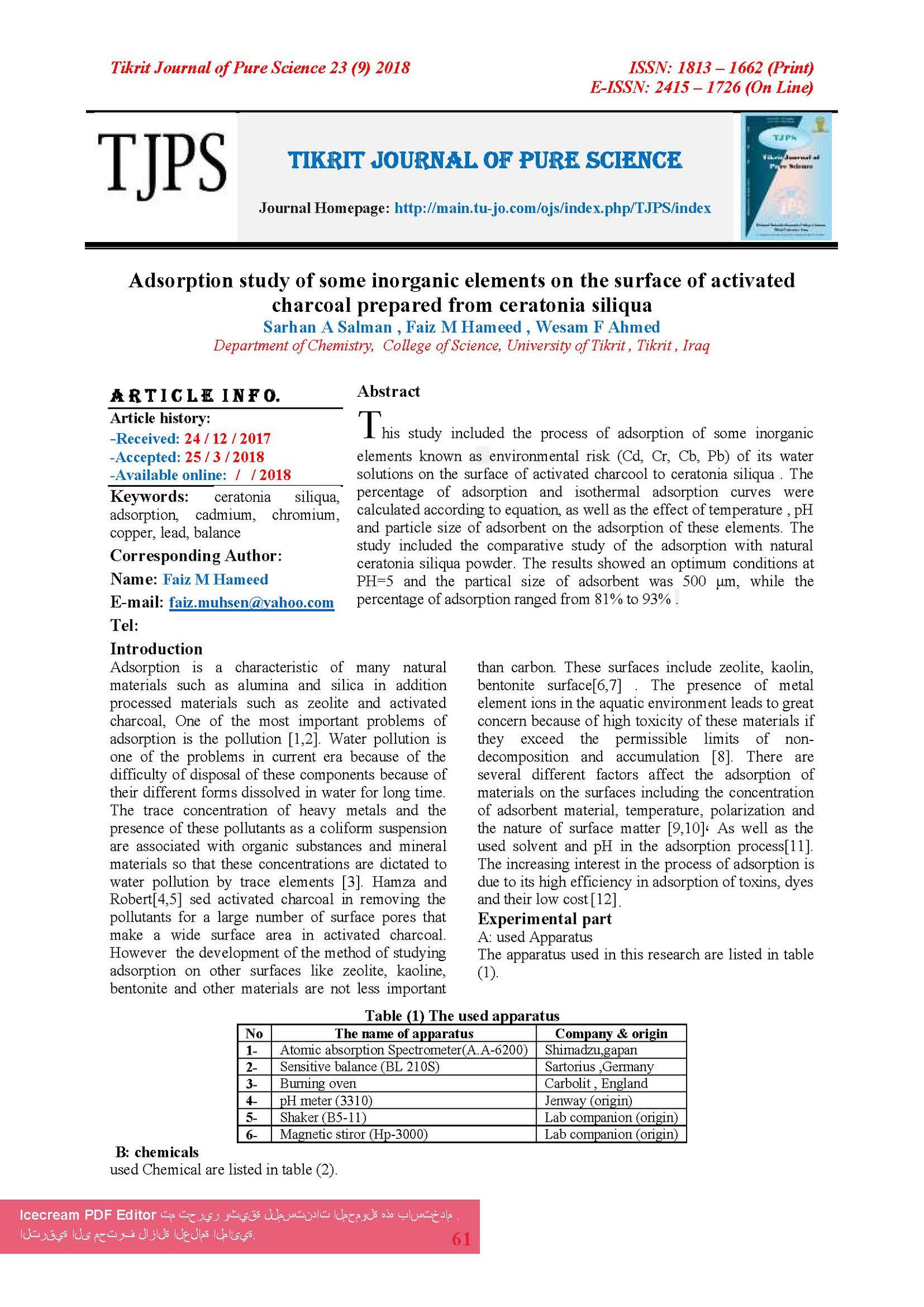Adsorption study of some inorganic elements on the surface of activated charcoal prepared from ceratonia siliqua
Main Article Content
Abstract
This study included the process of adsorption of some inorganic
elements known as environmental risk (Cd, Cr, Cb, Pb) of its water
solutions on the surface of activated charcool to ceratonia siliqua . The
percentage of adsorption and isothermal adsorption curves were
calculated according to equation, as well as the effect of temperature , pH
and particle size of adsorbent on the adsorption of these elements. The
study included the comparative study of the adsorption with natural
ceratonia siliqua powder. The results showed an optimum conditions at
PH=5 and the partical size of adsorbent was 500 μm, while the
percentage of adsorption ranged from 81% to 93%
Article Details

This work is licensed under a Creative Commons Attribution 4.0 International License.
Tikrit Journal of Pure Science is licensed under the Creative Commons Attribution 4.0 International License, which allows users to copy, create extracts, abstracts, and new works from the article, alter and revise the article, and make commercial use of the article (including reuse and/or resale of the article by commercial entities), provided the user gives appropriate credit (with a link to the formal publication through the relevant DOI), provides a link to the license, indicates if changes were made, and the licensor is not represented as endorsing the use made of the work. The authors hold the copyright for their published work on the Tikrit J. Pure Sci. website, while Tikrit J. Pure Sci. is responsible for appreciate citation of their work, which is released under CC-BY-4.0, enabling the unrestricted use, distribution, and reproduction of an article in any medium, provided that the original work is properly cited.
References
[1] Mortlan, S.S. and Boyd, S.A. (1986). clay organic complexes as adsorbents for phenol and chlorophenols. clays and clay minerals, (34): 581-585.
[2] Mavros, A.C.; Danilidon, N.K. and Stergion, L. (1994). color removal from A queens solutions, part 1, flotation Environ. technol, (15): 601-616.
[3] Pendias, A.K. (2001). Trace elements in soil and plants. CRC Press, 3rd edn.
[4] Hamza, A.A. and Hamoda, M.F. (1980). Industrial waste conference. purde university, Indiana: 151 pp.
[5] Robort, C.H. (1996). class notes. CE 4104 Water and waste water desing, Virginia. Tech: 37-48.
[6] Mobammed, A.F. (2005). m. sc. thess, universiy of babylen.
[7] Ramakisdna, K.R. and Viraghavan, T. (1996). american dyestuff reporter: 25-34.
[8] Jude, C.L. and Augustin A.A. (2007). Equilibrium sorption isotherm studies of ed (II). pb (II) and zn (II) ions detoxification from waste water. Unmodified and Electronic Jourmal of Biotechnology.Nigeria: 1-9.
[9] Al.Hyli, E.A.; AL-Dubuni, S.A. and Ramadhan, O.M. (2004). The effect of temperature PH and concentration on the adsorptive proportion of aromatic aminas and their substituments. Natioual Journal of chemistry, (16).
[10] Vpadnyay, S.N. and Vpadhya, Y.D. (1987). removal of phenols on adsorption in flyash. Journal chem tech. biotechnol, (37): 281-290.
[11] Artkines, P.W. (1996). physical chemistry 4th ed. Oxford university prss.
[12] Chatterjee. S.S.K. et al. (2010). Interaction of malathion, an organo Phosphorus Pcsticide with Rhizopus oryzae bio Mass. Journai of Hazardous Materials, 174(1-3): 47-53
